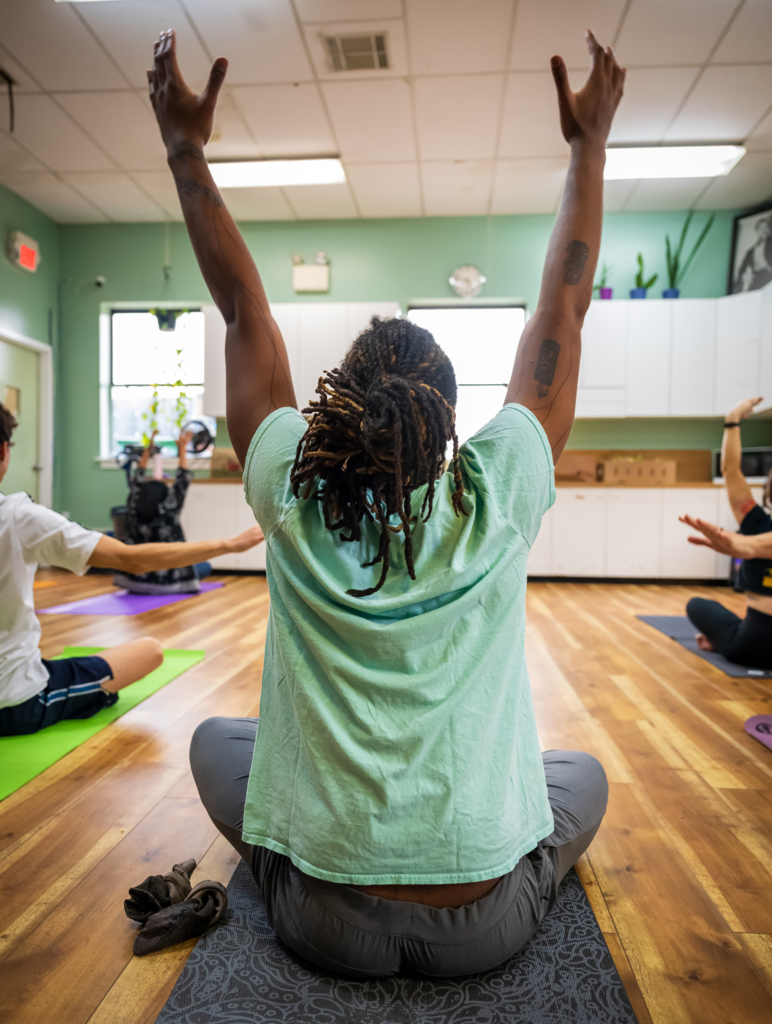During her first class at the local Women Against Abuse shelter where she lived, the little girl stood distant and silent while The Clay Studio teaching artist Nitza Walesca Rosario made a pot. After a few weeks, however, the moist clay and the shapes it took wrought wonders in the child.
“Working with clay is healing,” says Rosario, who’s also the studio coordinator. “By the fifth class, the little girl was my assistant, showing other people how to create pinch pots,” Rosario says of the process of rolling clay into a ball, poking an indentation two-thirds of the way down and pinching the sides into the desired shape and thickness. “She just blossomed. I’d witnessed it before.”
The class was brought to the shelter by one of the studio’s “Claymobiles.” Equipped with the materials and supplies needed for ceramics lessons, the vans take teaching artists to senior centers, schools, juvenile justice centers and facilities like the shelter. The two Claymobiles serve some 5,000 people within a 30-mile radius of the studio.

It’s part of the organization’s efforts to reach more Philadelphians with the healing power of clay.
Widely used in art therapy practice, working with clay has been shown to improve emotional regulation and release tension, among other benefits. A 2018 study showed that after six sessions of working with clay, people with disabilities scored higher on happiness evaluations than their peers who didn’t take part in the sessions. Along the same lines, PTSD UK, a British organization devoted to raising awareness of post-traumatic stress disorder, found that making pottery helps to heal people with PTSD.
“At times, words fall short in describing your emotions,” says Jay Bilinsky, a ceramic artist and programs assistant at the studio. “You can’t put your feelings into words, but you can put them into clay.”
Begun in 1974 by five artists who wanted to share working space, The Clay Studio is among the nation’s oldest centers for ceramics. Their new, four-story, 34,000 square-foot building in Olde Kensington has exhibition space, classrooms, studios, 24 kilns, a roof deck, a sculpture garden and a gift shop with the famed wall of more than 160 mugs in every conceivable style, shape and color.
The studio offers free weekly workshops and classes at nearby schools including Al-Aqsa Islamic Society, Moffett Elementary School and Kensington High School — as well as throughout the community with their Claymobiles. Some 4,500 students take classes each year, including workshop attendees and summer clay camp participants.

The staff has plenty of opportunities to see how making ceramic art nudges those involved toward more wholeness.
On a primal level, clay can bring us home from wandering in cyberspace, says Jennifer Zwilling, curator and director of artistic programs at the studio.
“In a digital world, clay is tactile,” she says. “It’s grounding, reassuring — it can be empowering. If children in difficult circumstances have a chance to mold clay as they wish, it may give them a sense of control.” In addition, if a child gives their handmade bowl or cup to someone they love, they may gain a sense of accomplishment and completion, as do some professional potters.
“My pots are complete when they are in service, bringing a sense of human connection to the user,” says studio resident artist and teacher Nate Willever of Mount Airy.
Then again, beginner potters often take pride in keeping their creations. Rosario speaks of a schoolgirl who brought one of her handmade bowls to a restaurant with her family. She ordered sushi and asked the waiter to serve her food in her bowl, which he did.
Not least important of clay’s healing properties is its inherent message of possible renewal. If an object doesn’t have the form one envisions, potters say, they can squish the clay and begin again. As autistic ceramicist Blake Zucker puts it: “Clay has a forgiving quality … that most materials don’t offer.”
Malika Turner, a recreation specialist at a senior center in Northeast Philadelphia, says that the Claymobile has provided popular workshops for four years.
“Even participants who have conditions affecting their hands enjoy the workshops,” Turner says. “One visually impaired person also likes to work with clay.”
Danielle Rossi, a painter and art director at North Philly’s Cristo Rey High School, has folded studio ceramics classes into her curriculum for eight years.
“Working with both hands puts you in the present moment, and that’s healing,” Rossi says. “Many of our students deal with hard things, but making pots provides a moment free of worry. I can’t change their lives, but clay can give them that respite.”
Attend a Class
Every Saturday and the second Thursday of each month, 5-7 p.m., at The Clay Studio, 1425 N. American Street, free with preregistration. For details on the wide variety of classes and workshops offered, visit public.theclaystudio.org/public/1/classes
Stay Tuned
Oct 9 — Dec 31, 2025
“Clay as Care” will examine the intersection of ceramics and health through scientific research, community programs and exhibitions. It will highlight work by studio resident artist Adebunmi Gbadebo, who uses clay from the South Carolina cemetery where her enslaved ancestors are buried to make large vessels to honor them, and California artist and Operation Desert Storm veteran Ehren Tool, whose 26,000 mugs use images of bombs, skulls, guns and skeletons to spark conversations about war. Both Gbadebo and Tool have work in Smithsonian museums. The program is funded by a recent $354,000 grant from The Pew Center for Arts & Heritage. For details visit theclaystudio.org/exhibitions/clay-as-care









